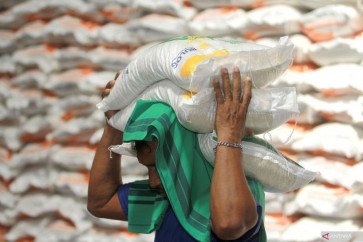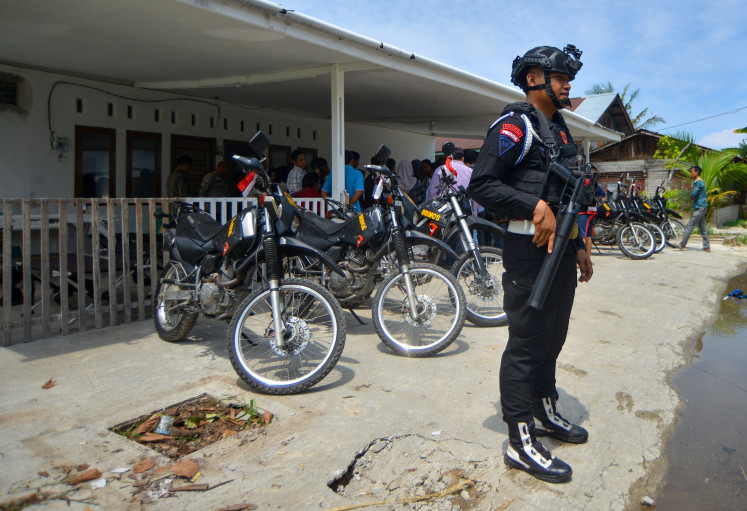Popular Reads
Top Results
Can't find what you're looking for?
View all search resultsPopular Reads
Top Results
Can't find what you're looking for?
View all search resultsConnectivity for inclusive development
For the first time since the Asian financial crisis of 1997, Indonesia has gained a momentum of economic growth and stability
Change text size
Gift Premium Articles
to Anyone
F
or the first time since the Asian financial crisis of 1997, Indonesia has gained a momentum of economic growth and stability. Last year, in spite of various global downturns, our economy grew by 6.5 percent, investment increased, people’s purchasing power improved and exports of goods and services continued to grow. A stable exchange rate was maintained and our foreign exchange reserves reached the highest level ever.
To everyone, of course, these facts show that the country has been successful in building and maintaining its economic growth.
However, recently we were all shocked to see Indonesia drop in the Global Competitiveness Index published by the World Economic Forum. The momentum of growth seems to be meaningless and the chance to expand and stabilize a global production network becomes less likely.
Further analysis reveals that doing business in Indonesia costs more due to poor connectivity. Traffic congestion in Greater Jakarta is a notorious example of a factor that deters investment.
Poor road quality across Java and the lack of a trans-Java expressway add to the costs of moving goods by road across our main island. Not surprisingly the latest Logistics Performance Index released by the World Bank rates the rail network in Java as being far worse than the average in ASEAN.
Outside Java, connections between ports and hinterlands are so poor they inhibit not only exports, but also domestic trade.
Shipment of a 40-foot container from many regional ports to Jakarta is more expensive than shipping the same container from Jakarta to Singapore.
High-quality products such as shrimp from Eastern regions cannot be transported efficiently to Java because the transport costs make them too expensive to be sold in Jakarta or exported to other Asian markets.
Our connectivity with our ASEAN neighbors and global markets are costly and far from efficient. Export opportunities are lost due to the high costs of connectivity, unreliability of transport and consequently sellers are not able to accommodate the requirements of buyers.
Tanjung Priok — our main international sea-freight gateway — is close to full capacity. Average dwell time of container ships is now six days compared to three days for major regional ports. Road access to the port has become increasingly congested.
With poor domestic connectivity, accompanied by inefficient connectivity with the rest of the world, in spite of the fact that our production costs are low and the quality of our products meets international standards, we are definitely unable to benefit from global production networks.
Further analysis reveals that doing business in Indonesia costs more due to poor connectivity. Traffic congestion in Greater Jakarta is a notorious example of a factor that deters investment.
Indeed, reliable connectivity, a web of economic centers across the country linked to the global market, are the key issues if we dare to compete.
To stay competitive, we must strengthen our integrity as a single economic power. We are not there yet. Our economy and wealth are highly concentrated in a few regions.
Many parts of the country are lagging, not integrated and experience low growth and relatively high
unemployment and poverty levels.
Urban and rural areas do not cooperate as agents of ‘”mutual symbiosis”. Rather, urban centers have a parasitic symbiosis with rural areas. As a result, a development bias towards urban centers occurs and more than half of our population lives in urban areas, leaving rural areas undeveloped and unattractive to investment.
Over the last 10 to 15 years, the country has seen a very high urbanization rate, the highest among ASEAN countries. And, of course, this has put pressure on existing urban infrastructure, causing bottlenecks that diminish economic productivity and inefficiencies, thus decreasing the competitiveness of our products.
To attain integrity, connectivity strategies must be those that acquire the beneficial symbiotic-dynamics interface between rural and urban — connecting lagging regions and growth poles.
Of course, improving infrastructure in disadvantaged regions will not in itself guarantee speedy economic growth because of their weak demand and agglomeration economies.
Rather, connecting lagging regions and growth centers can increase demand and promote economic concentration, such as agriculture, agro-processing and labor-intensive manufacturing. This would also lead to a significant increase in employment in the regions.
In the long run, the agglomeration within the regions will eventually develop, leading to the creation of their own smaller growth poles.
The foundation of connectivity is therefore to attain inclusive development and growth through unity rather than uniformity. The growth of our economy might be uneven for various regions, but increased connectivity will give people equitable access to social services and economic opportunities through improved access to markets.
Connectivity relies on the level of services of infrastructure networks — not on that of a stand-alone utility. In a network, the weakest links or nodes will define the quality of service for the entire network. The entire logistical chain of East Nusa Tenggara’s commodity stalls when a malfunction occurs in a small port. It reduces the level of services down to zero.
The obvious textbook remedy for connectivity is first to improve the level of service of the weakest-link, i.e., sub-national infrastructure serving as a link between lagging regions and growth centers — intra-island connectivity. This remedy of course requires incentives for local governments to build and maintain their own infrastructure.
Equally important, freeways or high-grade roads must be developed, as trucking is expected to be the backbone of land transportation connecting growth centers.
The cost of shipping must be reduced, as shipping is a very important mode of transport for trade between regions. Pioneer shipping must be backed up to improve inter-island cargo and passenger transportation — inter-island connectivity. Productivity of seaports must be enhanced and the cost of cargo handling must be reduced. New deep-water ports to serve trans-ocean vessels must be built.
A key ingredient in connectivity is a web of properly functioning logistic infrastructure that can effectively integrate local, regional and national markets. Connecting rural areas to local markets and to cities gives households improved access to goods, and provides services at lower and more stable prices and access to larger markets and, of course, job opportunities.
Greater integration between islands will reduce the impact of sudden shocks in production or demand-reducing price volatility. Cheaper and more reliable transport will increase market access as well as increase the competitiveness of our goods, as they can reach markets with a lower final price.
With improved connectivity with the global production networks, we will have greater diversification in production and exports as it helps businesses develop competitive advantages in higher value-added goods, both in terms of manufactured and processed commodities.
This is a logical “engineering” way of thinking to link a series of economic nodes for reduced logistical costs. For an economist, this is a challenging concept to counter-argue. They better come up with more appealing approaches to increase job opportunities and the degree of our competitiveness.
The writer is director for energy, mineral resources and mining at The National Development Planning Agency (Bappenas). The opinions expressed are his own.










